When Sarah transformed her dim living room into a lush indoor garden, her friends couldn’t believe it was the same space. You’ll find that strategic plant placement can dramatically change your home’s atmosphere, from bare corners that beg for a towering Fiddle Leaf Fig to empty walls yearning for cascading vines. Whether you’re working with a compact apartment or a spacious living area, these seven plant arrangements will help you create your own indoor oasis while maximizing every square foot of space.
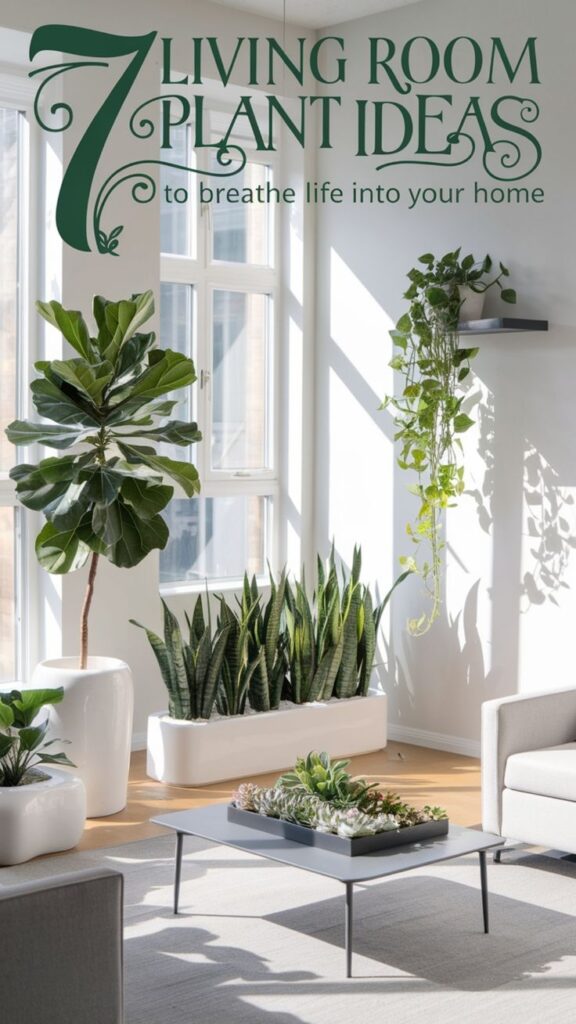
Contents
Statement Floor Plants for Empty Corners

Statement floor plants are dramatic, large-scale houseplants that serve as natural focal points in living room corners, adding vertical interest and architectural appeal to otherwise unused spaces. Popular options include Fiddle Leaf Fig, Bird of Paradise, Monstera deliciosa, and Dracaena varieties, which can grow several feet tall with impressive foliage patterns and shapes that command attention while softening angular room corners.
- Light: Most statement floor plants prefer bright, indirect sunlight; avoid direct afternoon sun
- Water: Water thoroughly when top 1-2 inches of soil feels dry
- Soil: Well-draining potting mix with good aeration
- Temperature: 65-80°F (18-27°C)
- Humidity: Moderate to high (40-60%)
- Container: Large, sturdy pot with drainage holes
- Space: Allow 2-3 feet of clearance around the plant
Regular dusting of large leaves with a damp cloth maintains photosynthesis efficiency and appearance, while rotating the plant quarterly ensures even growth.
Prune dead or yellowing leaves promptly, and inspect regularly for pests, especially on the undersides of leaves. As these plants grow, support larger specimens with stakes or moss poles when necessary, and repot every 2-3 years to prevent them from becoming root-bound and maintain healthy growth.
Vertical Garden Wall Displays

Vertical garden wall displays transform plain walls into lush, living tapestries of foliage and color, maximizing space in modern living rooms. These striking installations can range from simple hanging planters arranged in a pattern to complex modular systems with built-in irrigation.
Plants are arranged vertically using mounted containers, pocket planters, or specialized panels, creating a dramatic focal point that adds depth and natural beauty to interior spaces while improving air quality and acoustic properties.
- Light: Bright, indirect light is optimal; south or east-facing walls provide ideal exposure
- Water: Regular watering schedule varies by plant selection; most systems require 2-3 times weekly
- Soil: Well-draining potting mix with added perlite for proper aeration
- Humidity: 40-60% relative humidity for tropical varieties
- Temperature: Consistent indoor temperatures between 65-80°F (18-27°C)
- Spacing: 6-12 inches between plants, depending on mature size
- Support: Sturdy mounting system rated for the total weight when fully watered
Regular pruning, monthly fertilization during growing season, and systematic inspection for pest issues are essential for maintaining a healthy vertical garden.
Remove yellowing leaves promptly, rotate plants if growth becomes uneven, and dust foliage monthly to maintain photosynthesis efficiency.
Check mounting hardware quarterly to ensure structural integrity, and clean any drip trays or irrigation components to prevent mineral buildup or algae growth.
Tabletop Arrangements and Terrariums
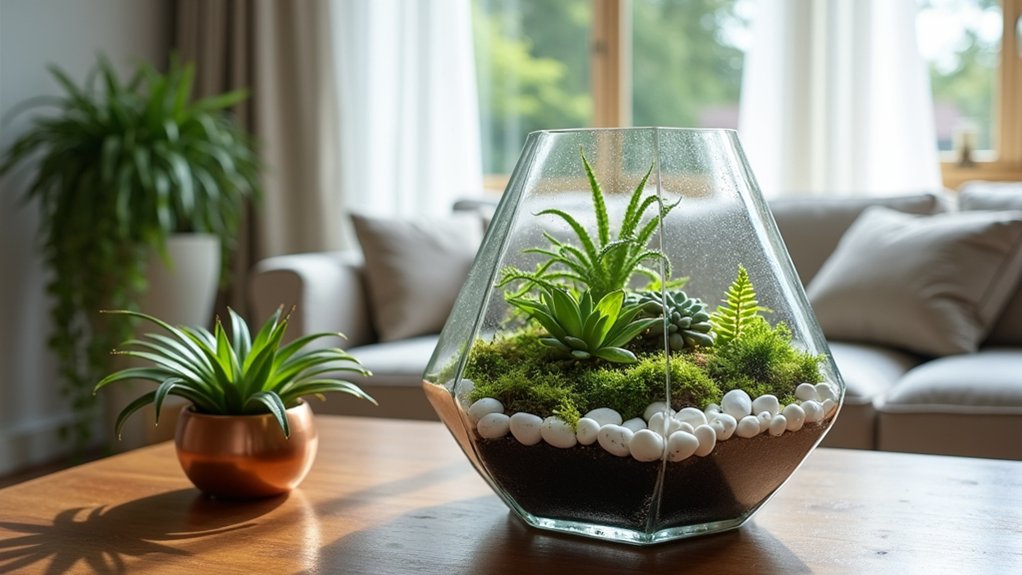
Tabletop arrangements and terrariums bring miniature garden landscapes into your living space, offering creative ways to display small plants in contained environments.
These decorative arrangements can feature multiple plants grouped together on coffee tables, side tables, or windowsills, while terrariums create self-contained ecosystems in glass containers that add visual interest through layered designs with stones, soil, moss, and carefully selected plants.
- Light: Bright, indirect light for most arrangements; avoid direct sunlight for closed terrariums to prevent excess heat
- Water: Moderate watering for open arrangements; minimal watering for closed terrariums as they recycle moisture
- Soil: Well-draining potting mix for arrangements; specialty terrarium soil mix with activated charcoal layer for terrariums
- Temperature: 65-80°F (18-27°C)
- Humidity: 40-60% for arrangements; naturally regulated in closed terrariums
- Container: Shallow dishes or decorative pots for arrangements; clear glass containers for terrariums
Regular maintenance involves trimming overgrown plants, removing dead foliage, and rotating arrangements to ensure even growth.
For terrariums, wipe glass walls to maintain clarity, prevent algae growth by opening occasionally to allow fresh air circulation, and prune plants before they touch the container walls.
Monitor plant spacing to prevent overcrowding, and periodically clean decorative elements like stones or driftwood to maintain the arrangement’s aesthetic appeal.
Hanging Plants for Layered Dimension
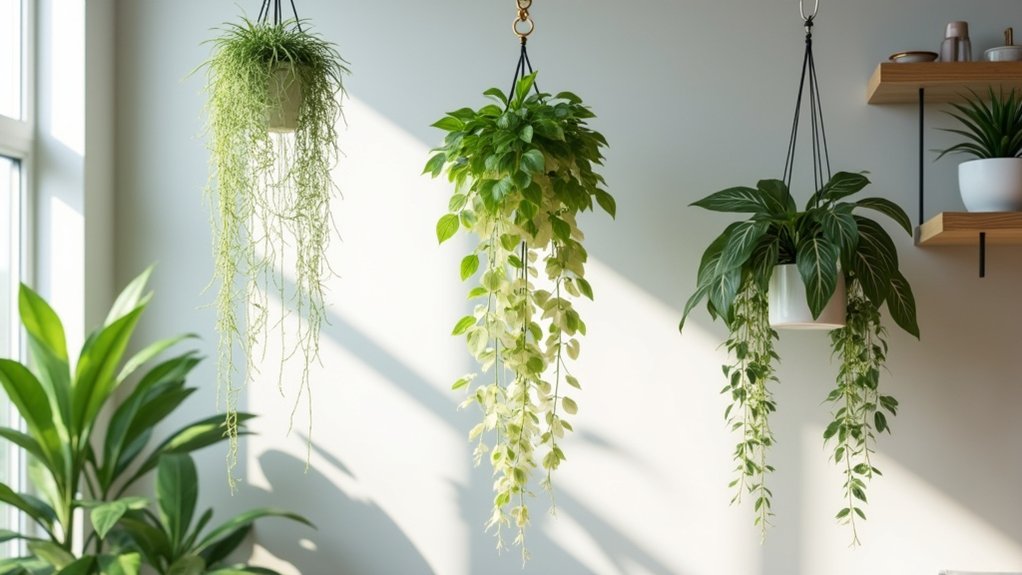
Hanging plants add visual interest and vertical drama to living rooms by creating multiple levels of greenery that draw the eye upward. These suspended specimens cascade from ceiling hooks, wall-mounted brackets, or elevated shelves, creating a lush, dimensional effect that transforms empty vertical space into a living display.
Popular choices like String of Pearls, Pothos, Spider Plants, and Boston Ferns offer varying textures and lengths of trailing foliage that can be layered at different heights.
- Light requirements: Bright indirect light to partial shade, avoiding direct sunlight that can scorch leaves
- Water needs: Moderate watering when top 1-2 inches of soil feels dry
- Humidity: 40-60% relative humidity, higher for tropical varieties
- Soil type: Well-draining potting mix with good aeration
- Temperature: 65-80°F (18-27°C)
- Container: Lightweight pots with drainage holes and saucers to prevent water damage
- Support: Sturdy mounting hardware rated for pot weight when wet
Regular grooming keeps hanging plants looking their best and prevents them from becoming unruly. Trim yellowed or dead foliage promptly, rotate pots quarterly for even growth, and dust leaves monthly with a damp cloth to maintain photosynthesis efficiency.
Check mounting hardware periodically for security, and consider periodic pruning to maintain desired length and fullness, using clean, sharp scissors to prevent damage to remaining foliage.
Window Ledge Plant Collections
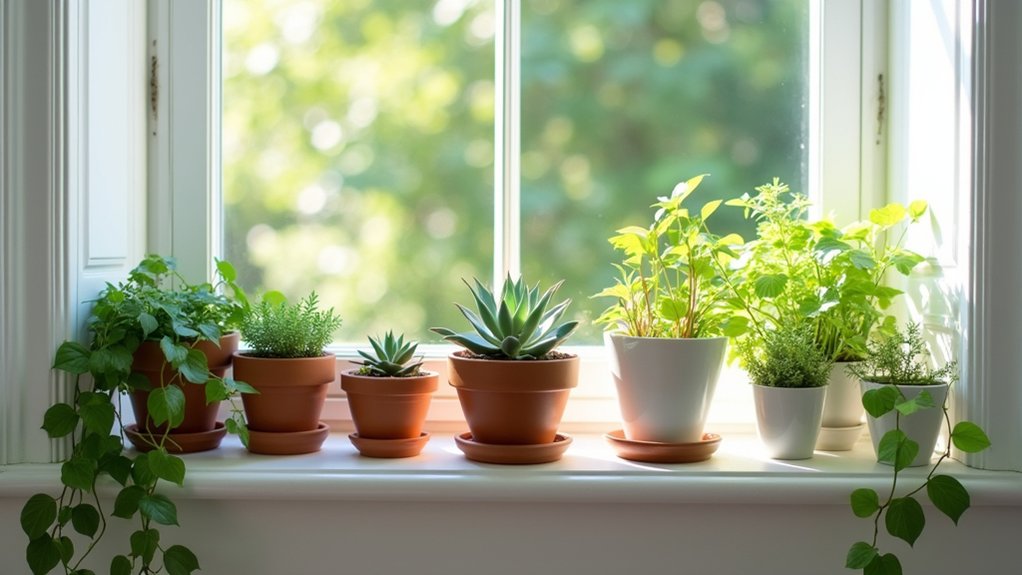
Window ledge plant collections transform ordinary windowsills into captivating green displays that maximize natural light exposure while creating visual interest through varying heights, textures, and colors.
These collections typically feature a mix of compact plants arranged in decorative containers, creating a living border between indoor and outdoor spaces that can include succulents, small trailing plants, compact herbs, and miniature flowering species.
- Light: Bright indirect light, with some tolerance for direct morning sun; protect from harsh afternoon sunlight
- Water: Varies by plant selection; generally water when top inch of soil feels dry
- Soil: Well-draining potting mix appropriate for each plant type
- Temperature: 65-75°F (18-24°C), away from cold drafts
- Humidity: Average room humidity (40-50%)
- Container: Pots with drainage holes, sized appropriately for windowsill width
- Spacing: 2-4 inches between pots to allow for air circulation
Regular grooming, rotation, and seasonal adjustments keep window ledge collections vibrant and healthy.
Rotate pots quarter-turns weekly to ensure even growth, trim leggy stems to maintain compact shapes, and adjust plant positions based on seasonal light changes.
During winter, move sensitive plants slightly back from cold windows and reduce watering frequency to prevent cold damage and root rot.
Group plants with similar care requirements together to simplify maintenance routines.
Shelf-Styling With Small Potted Plants
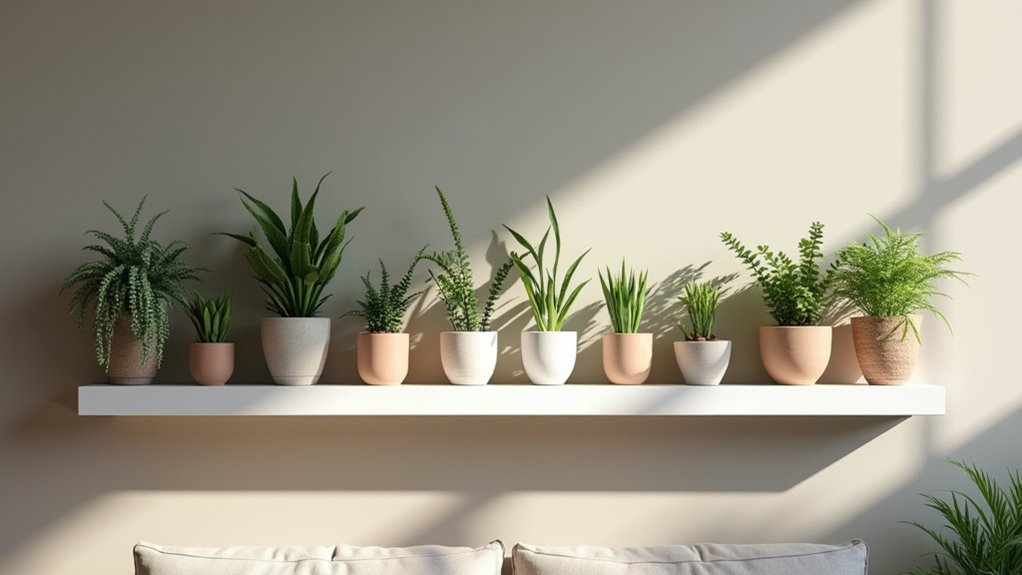
Styling shelves with small potted plants adds depth, texture, and a natural element to living room decor. Compact plants like succulents, air plants, trailing pothos, and small ferns can be artfully arranged on floating shelves, bookcases, or wall-mounted units to create eye-catching displays.
The key is varying heights, shapes, and leaf patterns while grouping plants in odd numbers for visual interest. Small decorative pots and unique containers further enhance the aesthetic appeal and can complement your existing room design.
- Light: Most shelf-suitable plants prefer bright, indirect light; avoid placing shelves in direct sunlight unless using sun-loving succulents.
- Water: Requirements vary by species; generally water when top inch of soil feels dry.
- Soil: Use well-draining potting mix appropriate for each plant type.
- Temperature: Most indoor plants thrive in 65-80°F (18-27°C).
- Humidity: Maintain moderate humidity levels; group plants together to increase local humidity.
- Container: Choose pots with drainage holes; use saucers to protect shelf surfaces.
Regular maintenance is crucial for shelf-styled plants to remain healthy and attractive. Rotate plants quarterly to ensure even growth, and dust leaves monthly with a damp cloth to maintain their appearance and photosynthesis efficiency.
Prune leggy growth to maintain compact shapes suitable for shelf display, and regularly check for signs of pests, which can quickly spread among closely grouped plants.
When watering, remove plants from shelves to prevent water damage to furniture and ensure thorough drainage.
Air-Purifying Plant Combinations
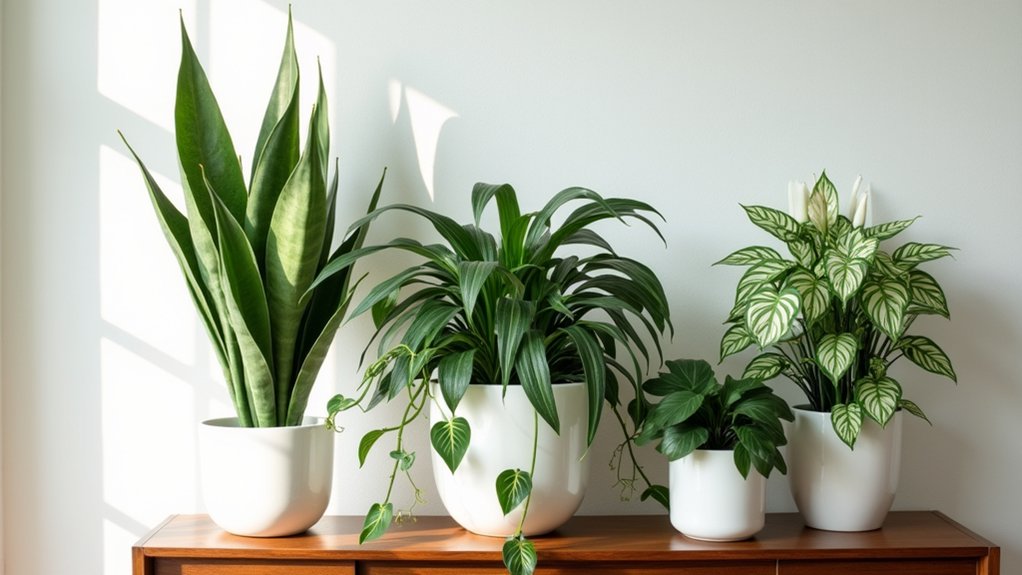
Air-purifying plant combinations create a natural filtration system in your living space by grouping together multiple plants known for their air-cleaning abilities. Common combinations include pairing snake plants with spider plants, peace lilies with bamboo palms, or pothos with dracaena varieties.
These groupings not only remove common indoor pollutants like formaldehyde, benzene, and carbon monoxide but also create visually appealing layers of different textures, heights, and leaf patterns that complement each other while maximizing air purification benefits.
- Light: Most air-purifying plant combinations thrive in medium to bright indirect light, avoiding direct sunlight.
- Water: Varied watering schedules depending on combination; generally water when top 1-2 inches of soil feels dry.
- Soil: Well-draining potting mix rich in organic matter.
- Temperature: Maintain between 65-80°F (18-27°C).
- Humidity: Average indoor humidity levels of 40-60%.
- Spacing: Allow 6-12 inches between plants to ensure proper air circulation.
To maintain healthy air-purifying plant combinations, regularly dust leaves with a damp cloth to maximize their filtering capabilities and ensure proper photosynthesis.
Rotate the plant grouping quarterly to promote even growth, and trim yellowing or dead foliage promptly to prevent disease spread.
Consider repositioning combinations seasonally to accommodate changing light conditions and periodically check for signs of compatibility issues between plants, such as competing root systems or varying humidity needs.
